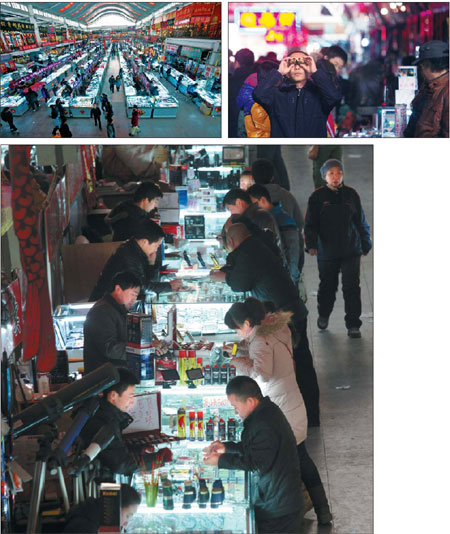
The Exotic Cargo Market in Tianjin was a major shopping destination for residents in North China in the 1990s. Vendors used to do good business selling secondhand clothes smuggled from overseas. Its popularity has waned, however, with most of the clothing
Designer labels are in fashion and easier for domestic customers to purchase now than at any time before, Tang Yue reports from Tianjin and Beijing.
Zhang Xiuhua ran a stall at the Exotic Cargo Market in Tianjin when it was at its peak.
"I had to get up at 3 am just to get a good booth on weekends," she recalled.
"The street was packed with customers from everywhere. It attracted far more people than any department store."
That was in the early to mid-1990s, when the market was the go-to place in North China for secondhand clothes and other goods smuggled from overseas.
By the end of the decade, the glory days were already over; crackdowns by customs authorities had severed supply chains, while brand-new foreign products were becoming readily available throughout the mainland.
Yet, as the Tianjin market declined, demand among Chinese shoppers for imported - especially high-end - goods has only grown stronger, with experts predicting that the country will this year overtake Japan as the world's largest luxury market.
More than 100 billion yuan ($15.88 billion) was spent on luxury products on the mainland last year, a year-on-year increase of about 25 percent, according to data released by management consultants Bain & Co.
The figure is a far cry from the 5 billion yuan recorded in 1998, when trade at the Exotic Cargo Market was starting to wind down.
Stylish entrance
The first Western-style fashion show in China is widely credited to Pierre Cardin, the French designer. He arrived in 1979 with 12 models eight French and four Japanese and set up a catwalk in the capital's Cultural Palace of Nationalities.
Two years later, another show was staged at the Beijing Hotel, this time open to the general public, not just fashion professionals.
"These shows broadened Chinese people's knowledge about clothing," said Zhou Ting, executive director of the University of International Business and Economics' luxury goods and services research center. "In an age when it was all blue, black and gray, for the first time people realized that their apparel could be colorful and beautifully designed."
Cardin went on to open his first Beijing boutique in 1989, with Louis Vuitton following suit three years later.
"No one was certain about the potential of the Chinese market at that time," Zhou said. "Big brands like Louis Vuitton simply believed that they needed to open stores in such a large country. Their prices were still too expensive for most Chinese customers. So it was more about the brand's reach than the profit."
Therein lied the attraction of the Exotic Cargo Market, which had been growing since the late 1980s, when a handful of sailors began selling secondhand suits on the street.
Although referred to in Chinese as "foreign garbage", the smuggled garments were superior to China-made products in textile and design. They were also much cheaper than clothes available in the foreign-owned boutiques.
"The prices were about the same as those in department stores, but the styles were very different," said Zhang, 57. "A lot of people traveled from Beijing or even further to shop at the market."
To replenish her stock, twice or three times a month Zhang would visit Jieshi, a town in South China's Guangdong province that acted as a trading post for secondhand clothes arriving into the port of Hong Kong.
Clothes were bundled into job lots, she said, with a bag of shirts costing about 200 yuan and jackets about 50 yuan.
"We picked the good ones and dumped ones that were too old or torn. Sometimes I kept some for myself," Zhang said. "In the early days (of the market), I was making 10 times the amount I had previously earned as a construction worker," said the trader, who eventually wound up her business in 1999.

Copyright ©1999-2011 Chinanews.com. All rights reserved.
Reproduction in whole or in part without permission is prohibited.